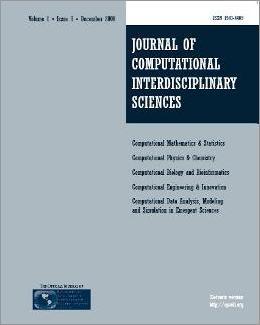
Editorial Office:
Management:
R. S. Oyarzabal
Technical Support:
D. H. Diaz
M. A. Gomez
W. Abrahão
G. Oliveira
Publisher by Knobook Pub


Editorial Office:
Management:
R. S. Oyarzabal
Technical Support:
D. H. Diaz
M. A. Gomez
W. Abrahão
G. Oliveira
Publisher by Knobook Pub
doi: 10.6062/jcis.2012.03.01.0051(Free PDF)
Vápenka P. and Schreiber I.
We describe a technique of constructing an anisotropic lattice of coupled subunits and apply it to assemblages of excitable myocardial cells conducting an electric impulse. The cells are assumed arranged in a planar network comprising a few thousands of cells, each having at most eight connections to neighbors. The connections are characterized as being one of four kinds: horizontal, vertical, diagonal and inversely diagonal. The connectivity in the cellular network is constructed randomly with prescribed fractions of each of the four kinds of connections. These fractions are taken from literature and characterize certain types of cardiac tissues, the left ventricle in particular. The nodes in the network correspond to cells, which are treated as point objects described by ordinary differential equations. For the model of the left ventricle we study spreading of the action potential initiated by an impulse stimulus of a small cluster of cells.
cellular network, excitability, action potential, cardiac waves.
[1] AIDLEY D. 1998. The physiology of excitable cells. Cambridge University Press.
[2] LECHLEITER J, GIRARD S, PERALTA E & CLAPHAM D. 1991. Spiral calcium wave propagation and annihilation in Xenopus laevis oocytes. Science, 252: 123-126.
[3] FRIDLYAND LE, TAMARINA N & PHILIPSON LH. 2010. Bursting and calcium oscillations in pancreatic beta-cells: specific pacemakers for specific mechanisms. Am. J. Physiol. Endocrinol. Metab., 299: E517-E532.
[4] DUPONT G, SWILLENS S, CLAIR C, TORDJMANN T & COMBETTES L. 2000. Hierarchical organization of calcium signals in hepatocytes: from experiments to models. Biochim. Biophys. Acta., 1498: 134-152.
[5] SCHAPER J, KOSTIN S, HEIN S, ELSASSER A, ARNON E & ZIMMERMANN R. 2002. Structural remodelling in heart failure. Exp. Clin. Cardiol., 7: 64-68.
[6] FISHLER MG, THAKOR NV & REID P. 1992. Propagation Wavefronts in Two-Dimensional Topologies of Cardiac Cell Net- works. Proceedings of the IEEE Conf. Computers in Cardiology, pp. 411-414.
[7] PANFILOV AV. 2002. Spiral Breakup in an Array of Coupled Cells: The Role of the Intercellular Conductance. Phys. Rev. Lett., 88(11): 118101.
[8] BUB G, SHRIER A & GLASS L. 2002. Spiral Wave Generation in Heterogeneous Excitable Media. Phys. Rev. Lett., 88(5): 058101. [9] MALATHI R & REDDY MR. 2007. A Simulation Study on the Effect of Ionic Mechanism Underlying Arrhythmias. IFMBE Proceedings, 14(2): 16-19.
[10] MALATHI R & REDDY MR. 2009. Effect of Gap Junction Conductance and Formation of Reentry in Human Ventricle Tissue - a Computational Study. Ind. J. of Biomech. (Special Issue NCMB):85-88.
[11] HAGBERG A, SCHULT D & SWART P. 2008. Exploring Network Structure, Dynamics, and Function using NetworkX in Proceedings of the 7th Python in Science conference (SciPy), G Varoquaux, T Vaught, J Millman (Eds.), pp. 11-15.
[12] NetworkX. http://networkx.lanl.gov/
[13] KOHOUT M, SCHREIBER I & KUB ́CEK M. 2002. A computational tool for nonlinear dynamical and bifurcation analysis of chemical engineering problems. Computers & Chemical Engineering, 26:517-527.
[14] LOEWENSTEIN WR. 1981. Junctional intercellular communication: the cell-to-cell membrane channel. Physiol. Rev., 61(4): 829-913. [15] ROHR S. 2004. Role of gap junctions in the propagation of the cardiac action potential. Cardiovasc. Res., 62(2): 309-322. [16] PERRIARD JC, HIRSCHY A & EHLER E. 2003. Dilated cardiomyopathy: a disease of the intercalated disc? Trends Cardiovasc. Med., 13(1): 30-38. [17] KATZ AM. 2011. Physiology of the heart, 5th ed.; Lippincott Williams & Wilkins; Philadelphia. [18] HODGKIN AL & HUXLEY AF. 1952. A quantitative description of membrane current and its application to conduction and excitation in nerve. J. Physiol., 117(4): 500-544.